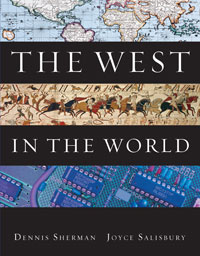
The West in the World, 4th Edition (Sherman)Chapter 9: The West Struggles and Eastern Empires FlourishChapter SummariesAt the beginning of the fourteenth century, declining agricultural productivity and bad weather combined to bring famine to Europe, checking population growth and driving people from their lands in search of food. This tragedy was followed by a terrible plague, the Black Death, which arrived in Europe via the trade that had flourished in the Mediterranean in the preceding century. This disease took the lives of over a third of the population. People reacted to the disaster with fear and despair, and in the case of peasants and urban workers, with revolt. The church was criticized for not bringing comfort and order, but it was absorbed in an internal crisis, as disputed papal elections led to controversy and the simultaneous rule of several popes. England and France engaged in a violent war, the Hundred Years' War, which devastated the lives of civilians and transformed the feudal order. Finally, in the east, new empires arose and threatened the borders of Europe. These disasters undermined the feudal order, bringing fears of the world ending, but instead the structures of social, political, economic, and cultural life would be transformed once again. |  |















